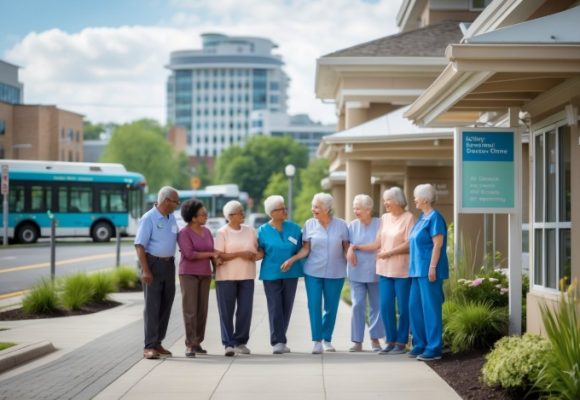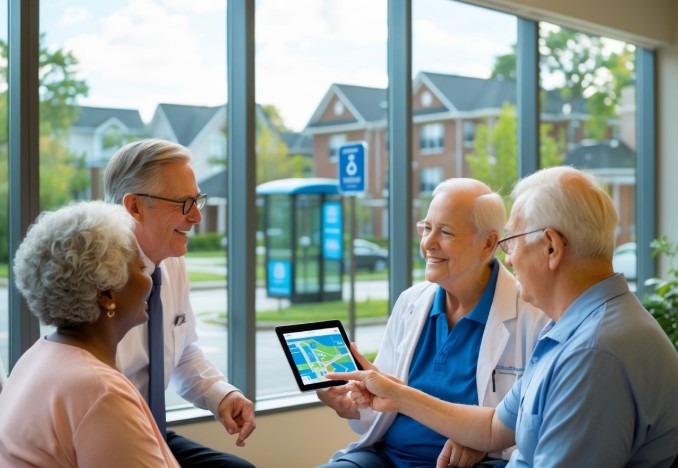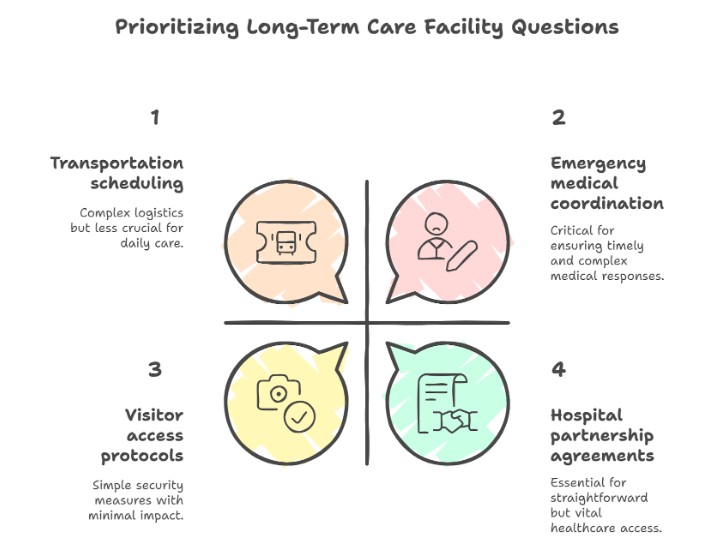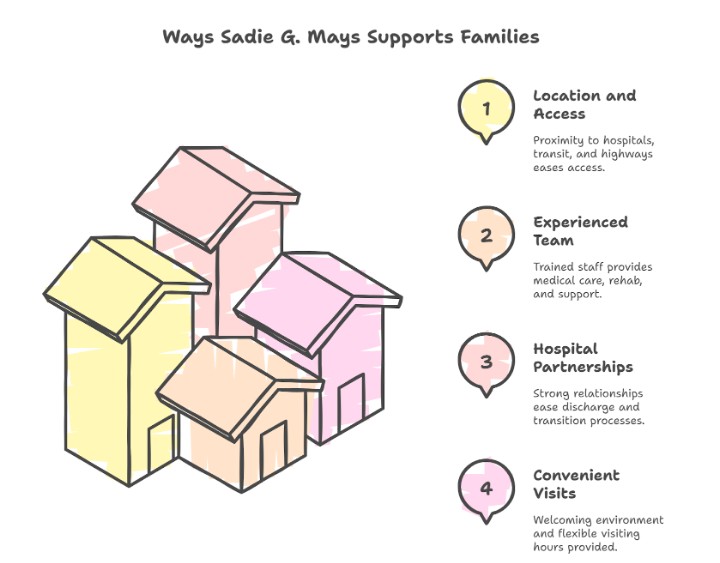Choosing a Long-Term Care Facility Near 30314: Transit, Neighborhoods & Hospital Discharge Tips
Originally published: August 2025 | Reviewed by Sadie Mays
Originally published: August 2025 | Reviewed by Sadie Mays

Finding the right long-term care facility for a loved one becomes increasingly challenging when location significantly impacts daily visits, medical care, and overall quality of life.
The 30314 area of Atlanta presents both unique opportunities and challenges for families seeking nursing home care, ranging from transportation options to proximity to hospitals.
Location factors like hospital access, public transportation, and neighborhood safety shape both resident care quality and family involvement in the long-term care journey.
It’s easy to forget that choosing the right long-term care facility means looking beyond just medical services and costs.
If you understand the perks and quirks of the 30314 zip code, you can make much smarter decisions about placement.
MARTA connections and nearby medical facilities significantly impact everything from emergency response times to the ease of visiting on weekends.

Location changes emergency response times, family involvement, and the overall safety of residents. Where a facility sits really does shape daily life for seniors and their loved ones.
Location is a significant factor in terms of convenience and comfort. Where you place a long-term care facility can significantly impact how it operates day-to-day.
Medical appointments become easier when facilities are conveniently located near hospitals and clinics. Residents need regular check-ups and specialist visits after discharge. If the facility is 30 minutes from medical centers, scheduling becomes challenging quickly.
Family involvement tends to drop off when facilities are difficult to access. Research suggests that residents who regularly see their family have better mental health.
If families have to tackle long drives or complicated routes, they tend to visit less often.
Safety depends on neighborhood conditions. Well-lit streets and low crime rates make it safer for residents to take walks. Staff tend to stay longer in safer areas, which helps maintain continuity of care.
Emergency response times tie directly to location. Ambulances reach facilities faster within city limits than outside.
Every minute counts in a medical emergency. A facility just 15 minutes from the nearest hospital offers better outcomes than one that’s 45 minutes away. Heart attacks, strokes, falls—these things can’t wait.
Fire and police respond quickly in urban areas. Rural facilities may wait longer for help, which is undesirable during medical crises or security incidents.
Hospital discharge planning runs smoothly when facilities have close ties to nearby medical centers.
Doctors can pop in more easily to coordinate care. Social workers can actually build relationships with staff at nearby facilities.
Regular family visits boost resident wellbeing and care quality. Senior living location really does affect how much families get involved in care and daily life.
Distance makes family visits harder. Families show up 40% less often when facilities are over 30 minutes away. People with jobs or kids just can’t make long drives every week.
Public transportation is a vital lifeline for families without access to cars. Facilities near bus lines or train stations get more visits, plain and simple. Elderly spouses often depend on public transit to visit their partners.
Convenient locations make it easier for families to join care meetings. Medical updates, therapy sessions, and discharge planning—they all need family input. When the facility is closed, it’s just less hassle to show up.
Where you put a facility really does affect safety, happiness, and long-term well-being. Neighborhood quality isn’t just a detail—it’s daily life.
Crime rates significantly impact resident safety. Facilities in high-crime areas often face security challenges for both residents and staff. Families worry more when their loved ones live in rough neighborhoods.
Local amenities enhance the quality of life for mobile residents. Parks, libraries, and shopping centers—they all give opportunities for supervised outings. Residents maintain more independence when community resources are readily available.
Weather and environment play a significant role in outdoor activities—facilities in areas with clean air and mild weather support better respiratory health. Residents spend more time outside when the neighborhood feels nice.
Staff recruitment gets easier in good neighborhoods. Quality caregivers prefer to work in safe and accessible environments. Better neighborhoods attract experienced nurses and therapists, which helps everyone.
The 30314 zip code sits in northwest Atlanta and covers historic neighborhoods with strong cultural roots. This area offers solid public transit access and is continually evolving due to major redevelopment.
The 30314 zip code covers three main neighborhoods in northwest Atlanta. Vine City sits closest to downtown and borders the Mercedes-Benz Stadium area.
Washington Park is just west of Vine City. The neighborhood has tree-lined streets and single-family homes.
The Atlanta University Center forms the southern part of 30314. This area is home to several historically black colleges and universities.
Key locations in 30314 include:
These neighborhoods sit around 2-3 miles from downtown Atlanta. Interstate 20 runs along the southern border of the zip code.
The 30314 area connects well to Atlanta’s public transit system. MARTA’s Blue and Green rail lines serve the nearby Vine City station.
The Vine City MARTA station sits at the edge of the zip code. Trains run every 10-15 minutes during busy periods and every 20 minutes during slower periods.
Bus routes:
These buses connect to other MARTA stations and major spots in the city. The system helps residents get around without cars.
Transit access makes it easier for families to visit long-term care facilities in the area. It also enables residents to access medical appointments and shopping areas.
At Sadie G. Mays Health & Rehabilitation Center, our Admissions team helps families in 30314 plan smooth transitions into care with hospital partnerships and easy access—contact us today to schedule.
If you’re ready to get started, call us now!
Families selecting long-term care facilities in the 30314 area benefit from being close to major medical centers and having reliable discharge planning services.
Effective planning between hospitals and care facilities reduces complications and helps smooth the transition from acute care to long-term settings.
The 30314 zip code sits just minutes from Grady Memorial Hospital and other major Atlanta medical centers. That kind of proximity gives long-term care residents a real edge if they need emergency services or specialized treatments.
Grady Memorial Hospital is the region’s main trauma center and safety net hospital. Residents in nearby facilities can reach emergency care within 10-15 minutes most of the time of day.
Key hospitals near 30314:
Shorter transport times mean faster access to critical care. That’s a significant concern for elderly residents with complex conditions who require frequent hospital visits.
Long-term care facilities near these hospitals often build relationships with medical staff. These connections help ensure that care remains consistent and communication between providers doesn’t fall through the cracks.
Hospital discharge planning helps prevent people from returning to the ER and supports safer transitions to the right level of care.
When hospitals skip good discharge planning, patients face more complications, medication mix-ups, and unnecessary emergency visits.
To ensure a smooth transition, hospital staff, long-term care facilities, and family members must all work together.
Discharge planning should focus on the patient’s specific medical needs and treatment goals—no one-size-fits-all approach here.
Critical elements of successful transitions:
Medicare requires hospitals to provide discharge planning for individuals transitioning to a skilled nursing facility. Hospitals must help find facilities that actually meet the patient’s medical needs.
Post-hospital care options may include skilled nursing, rehabilitation centers, home health services, or long-term care facilities. The right fit depends on the patient’s health and the level of recovery support they require.
Discharge planners at hospitals work closely with long-term care facilities to arrange placements. They assess the patient’s needs and attempt to match them with facilities that can provide the appropriate care.
When selecting a facility, discharge planners consider a range of factors, including medical complexity, therapy needs, insurance coverage, and the family’s preferences.
Discharge planner responsibilities include:
Long-term care facilities need to share clear details about what they can do. This helps discharge planners avoid bad matches and wasted time.
Families should also participate in these discussions. They know the patient best, so their input about preferred facilities, insurance, or special needs really matters.
CMS discharge planning rules prompt hospitals to prioritize patient goals and preferences.
When hospitals and long-term care facilities collaborate, readmission rates decrease. Transitional care programs have significantly reduced ER trips and hospital readmissions.
When coordination falls apart, patients miss meds, skip follow-up appointments, and chronic conditions slip through the cracks. That’s usually how preventable readmissions sneak in within the first month after discharge.
Strategies to prevent readmissions:
Facilities with strong hospital partnerships tend to keep readmission rates low. They share information better and maintain more consistent care.
Staff training on post-hospital care helps ensure that discharge orders are actually followed. Good facilities keep a close eye on new arrivals, especially in those first few weeks.
Quality long-term care centers track readmission patterns and use that data to keep improving their transitions.
Good transit options help families stay connected to loved ones in long-term care. The 30314 area has MARTA rail and buses, but reliable transportation is still a must for medical appointments and regular visits.
Families need dependable ways to get to the facility for visits. Location really matters when choosing long-term care, as it significantly impacts how easily you can visit or attend appointments.
Key Transportation Considerations:
Medical appointments, in particular, need rock-solid transportation. Residents often rely on family or staff to get to specialist visits outside the facility.
Some facilities offer their own rides for medical visits, but it’s smart to ask about this during a tour. Always check if there are any fees or usage limits associated with the service.
Three MARTA stations serve the 30314 area, making it easier to get downtown or to other parts of Atlanta. Each one has its own perks for families visiting long-term care facilities.
Ashby Station sits on the Green Line, connecting Bankhead and downtown. There’s parking and wheelchair access, which makes things easier for a lot of people.
Vine City Station is conveniently located near Mercedes-Benz Stadium and the downtown core. It can get crowded during big events, so travel times may be longer then.
West Lake Station marks the western end of the blue/green line and has the most parking of the three. It also links up with several bus routes.
Trains usually run every 8-10 minutes during rush hours, but they slow down to 15-20 minutes off-peak. Weekends run on a lighter schedule.
MARTA buses link neighborhoods throughout 30314, with main destinations and transit hubs. Route reliability can vary significantly depending on the line and time of day.
Primary Bus Routes:
During rush hour, buses show up every 15-30 minutes. Evenings and weekends can stretch waits to 45-60 minutes, especially if weather or traffic slows things down.
Older family members might struggle with bus travel. Boarding can be tough, and trips usually take longer than the train.
Parking—or the lack of it—can make or break regular family visits. In cities, many long-term care facilities often run short on parking, which can significantly hinder operations.
Essential Parking Features:
Facilities should spell out their parking rules, including any time limits or overnight policies. Some offer validated or discounted parking for families, which is always a plus.
Street parking nearby might mean meters or strict time limits. Families need to know these rules to dodge tickets during visits.
Parking fills up fast during peak visiting hours. Sometimes, families have to shift their plans just to find a spot.
Sadie G. Mays Health & Rehabilitation Center provides trusted Rehabilitation programs near Atlanta hospitals, ensuring safe recovery and convenience for families in 30314—reach out now to schedule your consultation.
If you’re ready to get started, call us now!

It’s smart for families to ask about hospital partnerships, transportation options, and neighborhood safety when checking out long-term care facilities.
These three factors significantly shape the quality of care and everyday life for residents in the 30314 area.
Essential questions about medical care should focus on the hospitals with which the facility partners.
It’s essential for families to know if the facility collaborates with nearby hospitals, such as Grady Memorial or Emory University Hospital.
Key partnership questions include:
Medicare and Medicaid coverage depend on these hospital partnerships. Some facilities only work with hospitals that accept certain insurance programs.
Inquire about the facility’s relationships with specialists, such as cardiologists, neurologists, and other doctors who may regularly consult with residents.
The facility should walk you through their process for medical emergencies. How do they coordinate with hospitals and keep families in the loop during transfers?
Transportation support can make a significant difference in how residents access medical appointments or even simple outings. It’s smart to ask if the facility offers rides to doctor visits or shopping trips.
Important transportation questions:
Many facilities charge extra transportation fees. It’s best to get these costs up front so there are no surprises.
Some places partner with local medical transportation companies. Others use their own vehicles and staff drivers to handle resident transportation.
Medicare might cover certain medical transportation costs. Families should ask how the facility manages Medicare transportation benefits and billing.
Ask about backup plans if regular transportation isn’t available. Residents still need to reach those important medical appointments, after all.
Safety measures and quality assurance encompass both facility security and the surrounding neighborhood. It’s wise to ask about crime rates and the safety protocols in place around the facility.
Critical safety assessment questions:
The 30314 area has different safety levels depending on the neighborhood. Review recent crime statistics and inquire with facilities about their approaches to addressing local safety concerns.
Facilities should clearly explain their emergency evacuation plans for situations such as fires or severe weather. These details matter, especially in unpredictable times.
Staff training on safety protocols is crucial. Inquire about the background checks conducted for employees and the type of ongoing safety training provided to all staff members.

Sadie G. Mays Health & Rehabilitation Center supports families through its Atlanta location, experienced staff, hospital partnerships, and amenities that focus on families.
The facility serves people in the 30314 area with several care options and easy access to essential services.
Sadie G. Mays Health & Rehabilitation Center is located at 1821 Anderson Avenue NW in Atlanta, GA 30314. The facility sits right in the heart of the area it serves.
Major Atlanta hospitals are close by. That helps with emergency transfers and medical appointments. Families can coordinate care between nursing home and hospital specialists with minimal hassle.
Public transit routes run along Anderson Avenue NW. If you take MARTA, bus lines connect to downtown Atlanta and other neighborhoods. That makes visits a lot easier for families who use public transportation.
There’s also quick highway access to I-20 and I-285. Families driving in from the suburbs can reach the facility fast. On-site parking is available for visitors.
Trained healthcare professionals provide skilled nursing care at the facility. Staff members offer medical care, supervision, and rehabilitation services.
Physical therapists help residents recover from surgeries or injuries. Occupational therapists focus on helping people regain daily living skills.
Speech therapists work with communication or swallowing issues. Licensed nurses provide 24-hour medical supervision, administering medications and monitoring health conditions.
The nursing staff works closely with doctors and specialists to coordinate ongoing care. Social workers guide families through insurance and discharge planning, and they connect folks with community resources.
They also provide emotional support to families during challenging transitions. Memory care specialists assist residents with dementia, using specialized techniques to manage behavioral symptoms. These experts really try to help maintain dignity and quality of life.
The facility has operated for more than six decades and has built strong relationships with Atlanta-area hospitals. These partnerships make the discharge process smoother for families.
Hospital social workers know the facility’s services and admission process. They can set up transfers quickly when patients require skilled nursing care, reducing waiting time and stress for families.
The care team gets detailed medical info from hospitals. They review medication lists and treatment plans before admission to ensure a smooth transition from hospital to skilled nursing care.
Insurance coordinators work with hospital billing departments to verify coverage for nursing home stays. Families get clear information about costs and payment options.
The facility accepts residents who need short-term rehab after hospital stays. Services include physical therapy, occupational therapy, and speech therapy. Many residents head home after finishing their recovery.
The facility was newly renovated in 2010, creating a bright and attractive setting. The modern environment feels welcoming and makes visits more comfortable for everyone.
Visiting hours work well for people with busy schedules. Evening and weekend visits are totally fine here.
The staff truly understands that family involvement makes a significant difference for residents. They encourage families to drop by whenever they can.
Common areas give families space to gather and catch up. For a quieter moment, private rooms are available for more intimate conversations.
There are also outdoor areas, which offer fresh air and a peaceful spot to visit. It’s nice to have options, especially on sunny days.
The facility provides peace of mind by offering quality care to families in need. Staff members keep families informed about their loved one’s condition and care plan.
The location near the 30314 area cuts down travel time for local families. It’s just easier to visit often when the place is close to home.
This proximity really helps families stay connected during long-term care stays. It can make all the difference.
Choose Sadie G. Mays Health & Rehabilitation Center for compassionate Long-Term Care with convenient access to 30314 neighborhoods, transit, and medical centers—contact us today to schedule your personal visit.
If you’re ready to get started, call us now!
Location affects emergency response times, family visitation, and hospital follow-ups, making it one of the most critical factors in long-term care decisions.
What neighborhoods are included in Atlanta’s 30314 zip code?
Atlanta’s 30314 area encompasses Vine City, Washington Park, and the Atlanta University Center, all of which are conveniently located near hospitals and public transit routes.
Which hospitals are near the 30314 area for long-term care residents?
Nearby hospitals include Grady Memorial Hospital and Emory University Hospital Midtown, providing quick access for emergencies and discharge planning.
How does hospital discharge planning help long-term care residents?
Effective discharge planning ensures smooth transitions from hospital to long-term care, reduces readmissions, and supports coordinated follow-up treatment.
What transit options serve the 30314 area?
MARTA rail stations, such as Vine City, Ashby, and West Lake, along with bus routes, offer reliable public transportation for families and residents.
How can families assess neighborhood safety near a long-term care facility?
Families can review Atlanta Police crime maps, check local redevelopment updates, and visit neighborhoods in person to gauge safety and comfort.
Why choose Sadie G. Mays Health & Rehabilitation Center near 30314?
Sadie G. Mays offers compassionate care, convenient access to hospitals, and easy transit connections, making it a trusted long-term care option for Atlanta families.